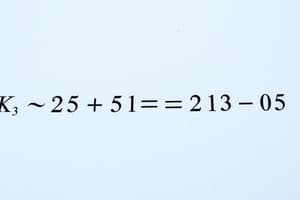Podcast
Questions and Answers
What is systematic bias associated with?
What is systematic bias associated with?
- Flawed experiment design
- Low precision
- Random variation
- Faulty equipment (correct)
How is random variation defined?
How is random variation defined?
- Unpredictable difference between observed data and true value (correct)
- Low precision in measurement
- High accuracy in measurement
- Predictable difference between observed data and true value
What causes systematic error?
What causes systematic error?
- Low accuracy (correct)
- High precision
- High accuracy
- Low precision
What minimizes parallax error?
What minimizes parallax error?
What reduces zero error?
What reduces zero error?
What is histology the study of?
What is histology the study of?
What does the extracellular matrix (ECM) contain?
What does the extracellular matrix (ECM) contain?
Which of the following is NOT a type of human tissue?
Which of the following is NOT a type of human tissue?
What is the purpose of taking a biopsy from an organ or tissue?
What is the purpose of taking a biopsy from an organ or tissue?
In gynecology, what is a common procedure to obtain a sample from the uterus?
In gynecology, what is a common procedure to obtain a sample from the uterus?
What does HPE stand for in the context of tissue examination?
What does HPE stand for in the context of tissue examination?
What information does a report from HPE provide?
What information does a report from HPE provide?
To rule out malignant conditions of the uterus, which sample might be taken?
To rule out malignant conditions of the uterus, which sample might be taken?
What does the extracellular matrix (ECM) support?
What does the extracellular matrix (ECM) support?
Which type of tissue is responsible for body movement?
Which type of tissue is responsible for body movement?
Flashcards
Artifacts in Stained Slides
Artifacts in Stained Slides
Imperfections in stained slides due to fixation, reagents, or sectioning.
Staining of Tissue Sections
Staining of Tissue Sections
Dyes selectively stain tissue components for microscopic study.
Basic Dyes
Basic Dyes
Dyes with affinity for anionic components (e.g., nucleic acids).
Acid Dyes
Acid Dyes
Signup and view all the flashcards
H&E Staining
H&E Staining
Signup and view all the flashcards
Trichrome Stains
Trichrome Stains
Signup and view all the flashcards
PAS Reaction
PAS Reaction
Signup and view all the flashcards
Lipid Staining
Lipid Staining
Signup and view all the flashcards
Final Step in Slide Preparation
Final Step in Slide Preparation
Signup and view all the flashcards
Bright-Field Microscopy
Bright-Field Microscopy
Signup and view all the flashcards
Study Notes
Artifacts in Stained Slides
- Artifacts in stained slides can result from various causes, including improper fixation, type of fixative, poor dehydration, improper reagents, or poor microtome sectioning.
Staining of Tissue Sections
- Most cells and extracellular material are completely colorless, and to be studied microscopically, tissue sections must be stained (dyed).
- Dyes stain material more or less selectively, often behaving like acidic or basic compounds.
Types of Dyes
- Basic dyes, such as toluidine blue, alcian blue, and methylene blue, have an affinity for anionic components like nucleic acids and are termed basophilic.
- Acid dyes, such as eosin, orange G, and acid fuchsin, stain acidophilic components like mitochondria, secretory granules, and collagen.
Hematoxylin and Eosin (H&E) Staining
- H&E is the most commonly used staining method, with hematoxylin staining DNA in the cell nucleus, RNA-rich portions of the cytoplasm, and the matrix of cartilage, producing a dark blue or purple color.
- Eosin, as a counterstain, stains other cytoplasmic structures and collagen pink.
Other Staining Methods
- Trichrome stains, such as Masson trichrome, allow greater distinctions among various extracellular tissue components.
- The periodic acid-Schiff (PAS) reaction stains carbohydrate-rich tissue structures, such as polysaccharides, distinctly purple or magenta.
- The PAS reaction can be modified to specifically stain DNA in cell nuclei.
- Lipid-rich structures can be revealed by avoiding lipid-removing processing steps and staining with lipid-soluble dyes like Sudan black.
Slide Preparation
- Slide preparation, from tissue fixation to observation, can take from 12 hours to 2.5 days, depending on the size of the tissue, the embedding medium, and the method of staining.
- The final step before microscopic observation is mounting a protective glass coverslip on the slide with clear adhesive.
Bright-Field Microscopy
- With the bright-field microscope, stained tissue is examined with ordinary light passing through the preparation.
- The microscope includes an optical system and mechanisms to move and focus the specimen.
Studying That Suits You
Use AI to generate personalized quizzes and flashcards to suit your learning preferences.




